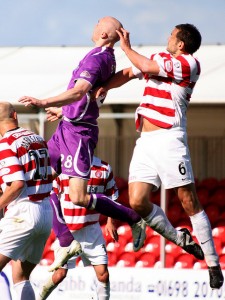E-letter and update by Dr Ian Beasley (FFSEM)
In response to:
Jo Price, Peter Malliaras, Zoe Hudson. 2012. Current practices in determining return to play following head injury in professional football in the UK. Br J Sports Med 2012; 0: 201109068 (Original article). [this paper is Online First and is included in the upcoming November Print Issue of BJSM [BASEM Theme Issue].
 There is no doubt that since the first consensus statement on concussion, conceived in Vienna in 2001 (read BJSM summary article here), every sport has raised its game on head injury and concussion management and reviews by the various sports over the years have resulted in updated and improved practice.
There is no doubt that since the first consensus statement on concussion, conceived in Vienna in 2001 (read BJSM summary article here), every sport has raised its game on head injury and concussion management and reviews by the various sports over the years have resulted in updated and improved practice.
Football in this country has been similarly active. At the behest of the FA medical committee, and as a result of collaboration between an eminent Premier League medical officer, and a Neurosurgeon working in sport, the current FA head injury guidelines were devised. They were circulated to clubs in November 2009, and have been in use since then.
Since its inception the SCAT 2 form has been included in these guidelines, and is published as part of the head injury guidelines in the FA handbook (1), and on our website (here).
In their study Price et al (2) mention that many club medical officers ‘are not required to demonstrate any expertise in concussion management’.
Medical indemnity providers have insisted for some time that medical practitioners attending sporting events must ensure they are adequately trained to provide appropriate care for their athletes (3). We would encourage any medical practitioner involved in sport to heed this message.
The initial questionnaires in this study (2) were sent to clubs before the availability of current guidelines. By the time the second batch of questionnaires were sent out, all clubs were in receipt of the current guidelines from the FA. Hence, by the time conclusions were drawn in this study, they were not contemporary. They do not reflect current practice within professional football. Nor do they represent the stance of the FA in dealing with this important issue.
In my experience, governing bodies and their medical officers will always be of help when trying to obtain up to date information regarding practice and policy within their respective sports if asked.
References
1. The FA Handbook, Rules and Regulations of The Association, season 2012-13.
2. Current practices in determining return to play following head injury in professional football in the UK. Price, J., Malliaras, P., Hudson, Z. Br J Sports Med 2012;0:1-5
3. MPS issues advice to doctors assisting at sporting events : 07 Jul, 2006.
Editor’s note – link to the most current consensus document here – the Zurich (3rd) concussion guidelines (>47,00o page views as of October 8th, 2012).
**************************************************************
Dr Ian Beasley MBBS, MRCGP, MSc, DIP.Sports Med, FFSEM (UK) is Head of Medical Services Club England Division The FA Group Wembley Stadium, Wembley, London, HA9 0WS Ian.beasley@thefa.com